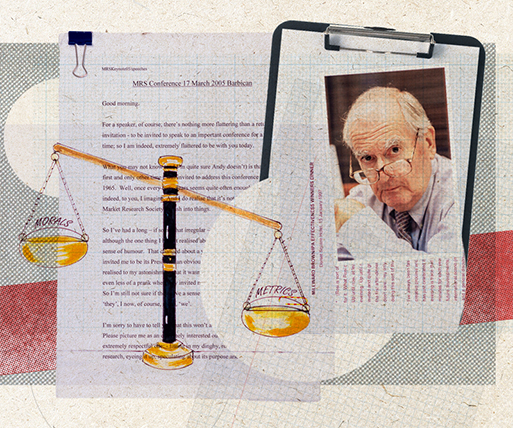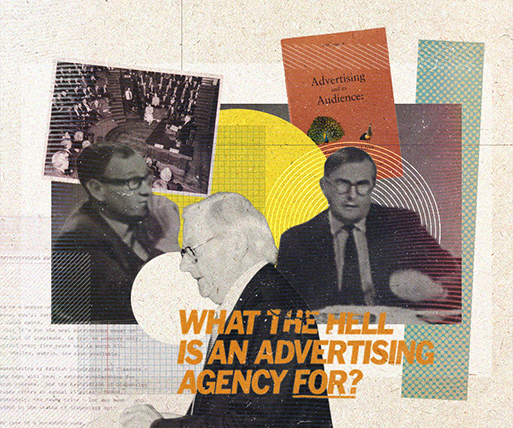The consumer has a mind as well as a stomach, 1972
- Date: 1972
- Publisher: WARC, and delivered at many events
- COMMUNICATIONS
This key piece started life as a presentation to Kraft Foods and was first aired in 1972. There were many later iterations, but a memorable version can be found on p.139 of “Behind the Scenes in Advertising Mark III”. Its publication coincided with Stephen King’s development of the T-Plan (or Target Plan) as part of the new JWT Account Planning Department. This approach recommended combining market research and consumer insights to develop more effective and creative advertising and Jeremy enabled it to be a potent influence on JWT’s creative output. What became JWT London standard practice was adopted in many other JWT offices around the world, and it is a fine example of how Stephen King and Jeremy thought and worked in parallel, arriving at similar conclusions through different routes.
The consumer has a mind as well as a stomach
Being the creative director in an advertising agency means spending a great deal of time discussing and evaluating work done by others. Much of the development work you are shown seems wrong; either strategically wrong or executionally wrong.
When it is strategically wrong, it is relatively easy to explain why you want it changed but when you feel the execution is at fault, the problem becomes a great deal harder. It never seemed satisfactory - or fair - simply to say, ‘This isn't good enough, start again.’ I always felt the need to try to explain why; to try to relate the specific rejection to a more general principle. ln this way, disappointments could at least be part of a learning process - and, besides, it was good for me to try to explain and justify my decision.
The problem was, there were (and are) few sensible and well-articulated theories about how adverting works. There are some ‘rules’, some sets of beliefs about what is good or bad, but very little communications theory, however inadequate, on which to build and against which to test a particular instinct about a particular proposal. Again and again l found myself having to explain that saying something did not mean that you had communicated it; and almost as often, that not having said something didn't necessarily mean that you had not communicated it.
The first time I put these thoughts together in public was in 1972 to a Kraft lnternational Management Conference in Switzerland. The first two editions of this book carried the presentation more or less exactly as I first gave it. Since then, I’ve made similar presentations on a great many occasions in the course of which I’ve dropped the almost totally irrelevant original introduction and added a few more examples and illustrations. That is the version printed here. It’s probably best known as Stimulus & Response. I remain extremely grateful to Terry Hamaton for the illustrations.
There seem to be curiously few books about the nature of communications that are of practical help to those working in advertising
But those that do exist seem to be unanimous in believing the communications process to be composed of four distinct component parts.
There’s a Sender:
A Receiver:
A Medium:
And a Message:
The man in the big boat says ‘Get out of my way!’ to the man in the little boat. The man in the little boat dutifully gets out of the way, and the communication has been successfully completed. It all seems very simple, doesn’t it? But let’s see if the same model can be applied to other forms of communication.
Here’s another sender - an advertiser (or rather, an art director’s mental picture of an advertiser):
He, too, has his receivers - his potential customers:
Again, there’s a medium - in this case, television:
But what about the message? Well, that’s not particularly difficult because the advertiser knows exactly what he wants the consumer to do. He wants the consumer to buy his product. So the message, obviously, is:
You may think this slightly unfair since little advertising these days is quite as blatant and aggressive in its tone. But read your newspapers and watch television and there’s still a lot of advertising instructing us to ‘buy some today’. And no election campaign is without bald injunctions to VOTE CONSERVATIVE (or indeed any other party for that matter).
The main question arising here is this: if the man in the little boat responds so obediently, why aren’t consumers and voters so thoughtfully compliant? Either we hold the view that all consumers are irresponsible and should be subjected to heavy fines if they fail to consume - or we look for some other explanation.
So let’s look at another communicator - another sender:
A comedian, a funnyman. He, too, has his receivers:
...a typical British family on a night out, determined under no circumstances to enjoy themselves.
The comedian's medium, of course…
...is his voice. But what’s his message? Well, he knows what he wants his receivers to think, all right. He wants them to think he’s funny. But I very much doubt if any comedian, at least more than once, would get up on stage and begin by saying: ‘Ladies and gentleman ...
.. the first thing you should know about me is that I am funny.’ And I
very much doubt if that audience would leave the theatre still chuckling and tell their neighbours the next day just what a funny person they’d seen the previous evening: ‘We knew at once he was funny because he told us so.’
The comedian is a far more skilled communicator than that. He knows that if his audience is to think he’s funny, then he's got to make them laugh; he's got to tell them what we call a joke.
So he tells the joke...
... and the audience laughs. It is their response that he’s funny. They come to that conclusion; it’s their contribution, not the comedian’s.
And it’s this illustration that begins to cast serious doubt on the usefulness of the normal communications model of sender, receiver, medium and message. The real flaw in that theory is that it in no way allows for the participation - the creativity - of the receiver.
And like it or not, all receivers do participate. They resolutely refuse to sit there with minds like empty sponges, accepting all that they’re told without question or modification. For example, at the moment, I’m a sender; and you, unfortunately for you, are receivers. Suppose I were to tell you in all seriousness that I was a man of many remarkable qualities
- so many, in fact, that I found it difficult when asked to say which of my qualities was the most remarkable. My integrity was certainly widely admired, as was my compassion; but if forced, I’d have to say that of all my qualities, the most remarkable had to be my modesty. ‘I’d like you to know,’ I’d say, ‘that I’m un extremely modest man.’
Well, that’s my message. But do you accept it? Do I see you turning to each other and murmuring respectfully, ‘What a modest man! Did you hear him tell us he was modest? I never knew before that he was modest!’
I suggest you don’t. I suggest that, in fact, you arrive at a diametrically opposite conclusion. You conclude that my most pronounced characteristic is that, not of modesty, but of conceit.
In his book Human Communications,1 Professor Aranguren says this: ‘The emission does not always and inevitably lead to the simple quiet and passive reception of a message, but frequently excites an active response: and for the same reason, this response may be in opposition to the emission instead of conforming with it.’
But with due respect to the good professor, I don’t think he’s got it absolutely right even yet - because he’s still using this word message. And the word message is a very dangerous word because we use it to stand for two quite different things and we don’t always distinguish between them. Sometimes we use the word message to mean that which the sender puts into a communication; and sometimes we use it to mean that which the receiver takes out of a communication. And however inconvenient and untidy it may be, we have to realise that these two can be - indeed, almost always are - completely different. How can the same word, message, be applied to that which I put in, ‘I am modest’ and that which you take out, ‘He is conceited’?
It seems to me, therefore, that if we are to avoid all sorts of problems when creating or discussing communications, we need to think of them as being composed not of four standard component parts, but of five:
Sender:
Receiver:
Medium:
Stimulus:
... and Response:
And the key words here, obviously, are the two words ‘stimulus’ and ‘response’ replacing the single word ‘message’.
‘I am modest’ is not a message: it’s a stimulus. Just as ‘He is conceited’ is a response. There’s no longer any conflict or confusion.
The most effective communicators don’t rage at their receivers’ insistence on contributing to communications; they welcome it and turn it to their advantage.
In 1960, in the United States of America, the young John F. Kennedy was challenging Richard Nixon for the Presidency.
Though long before Watergate, the Nixon reputation was not altogether without blemish - and it was part of the Democrats’ strategy to bring into public question the Nixon integrity. If this was their ‘message’, they might well have been tempted to publish an advertisement like this:
Had they done so, they would have run the serious risk that at least some part of the electorate would have found such an unsubstantiated slur unacceptable. Their response, therefore, would have been to challenge it.
Instead, both famously and infamously, they published this:
Here is a deliberate invitation to the audience to participate. Making effective (if disreputable) use both of Nixon’s slightly dodgy reputation and his slightly shifty appearance, the creativity of the receivers is actively sought and utilised. Not entirely coincidentally, perhaps, Nixon lost by a narrow margin.
So receivers do not receive passively, with empty heads; they receive actively, and it is up to senders to turn this contribution to their advantage.
In his dense but thoughtful book, The Act of Creation, Arthur Koestler says this: ‘Language itself is never completely explicit. Words have suggestive, evocative powers; but at the same time they are merely stepping stones for thought. The artist rules his subjects by turning them into accomplices.’
That seems to be as good a definition as I know of the role of creative people in advertising. We have to try to turn our audience into accomplices; because if they aren’t our accomplices, they will be our challengers.
Herc is a real advertisement:
How primitive, we think. How touching and unsophisticated! Some elderly smallholder, no doubt, eking out his pension. He’ll probably do all right as long as he doesn’t try to expand.
But imagine if he did, and called in a sophisticated London communications consultancy. It’s not totally impossible, in the interests of modernity and legibility, you understand, that they might recommend their client to adopt something like this:
There’s been no change of strategy, please note; nor even of copy. Just the introduction of a familiar typeface, Helvetica.
They might even think it worth testing something along these lines:
Because responses to common stimuli are subjective, they are also individual - so I can’t be certain how each of you may have responded to those three different advertisements. But I’m reasonably confident that most of you, and indeed most urban egg choosers, would think less well of the eggs offered in the second two advertisements than of those offered in the first.
In fact, of course, if you look back, that original Fresh Eggs sign is a little masterpiece of brand communication. However inadvertently, everything about it triggers the right sort of response: the meticulously hand-lettered sign (but clearly not by a professional art director); not a weed in the flowerbed; the sign not quite straight; the carefully cut grass.
Each of these tiny triggers leads to a rich, internal, coherent composition: a small number of happy, organically fed, free-range hens looked after personally by a compassionate owner. The word ‘fresh’ here is redundant: how could they be anything else? Whereas in the second two examples, the typography has not only decided to fight the word ‘fresh’, it has comprehensively won.
The great skill in designing brand communications is in selecting those tiny triggers, because those that are uniquely right for one brand will by definition be wrong for another. Here is another brand looking for your custom:
I have repeatedly said that consumers’/receivers’ interpretation of brand stimuli is active - is creative. This sign says, factually and accurately, what service is on offer. And that’s all it says.
But what does it imply? What does it communicate? A very, very old flying instructor? A very, very old aircraft? A grass landing strip with mole hills? Decomposing World War II tarmac? Not much maintenance? An open cockpit? Again, each individual receiver will have constructed a slightly different internal mental picture. But I don’t think many of you would have chosen this brand. A bit of boring old Helvetica here would not have come amiss.
Wise communicators spend at least as much time thinking about their receivers - about what’s in their heads already, about how they might interpret, mis-interpret, decode, modify any given stimuli - as they do on the creation of those stimuli. Here’s one communicator who failed to think hard enough:
To the sender, the farmer, an entirely reasonable and accurate statement about the availability of two items of farm produce. To the squeamish receiver, mind as ever active and inventive, a deeply off-putting association. Irrational, certainly, but senders should never be surprised by receivers’ irrationality.
I’ve left, of course, one question unanswered. If you can’t tell people what to do; if you've got to rule your subjects by turning them into accomplices; then why did this work?
Why did the man in the little boat get out of the way of the man in the big boat?
The answer, of course, is that he had to; because if he hadn’t, he’d have been dead: a motivation more powerful that those normally available to advertisers. The stimulus here resides not in the message but in the relative sizes of the sender and receiver. This sort of communication has nothing to do with persuasion; it is coercion. It depends for its success on the ability of the sender to penalise the receiver for disobedience. It is the communications equivalent of gunboat diplomacy.
The advertiser, fortunately, is never in such a position of power. He is always less powerful than the sum of his potential customers; and his potential customers know that they can always go elsewhere.
The advertiser can only succeed if he seeks and earns the willing complicity of his audience.





